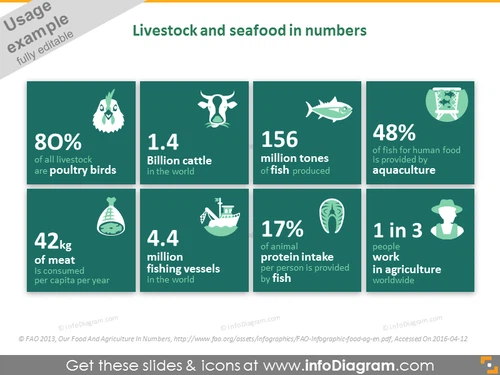Animal husbandry and fishery numbers
from deck
Food and Agriculture icons - Animal husbandry, Fishery (PPT flat clipart)
- Info
- How To Edit
- Usage example
Info
Livestock and seafood in numbers
Slide Content
The slide presents statistical data related to livestock and seafood, emphasizing their importance in global food production and consumption. The title "Livestock and seafood in numbers" sets the topic. It enumerates various statistics: 80% of all livestock are poultry birds, highlighting the dominance of poultry in the livestock sector; 1.4 billion cattle in the world, presenting the global cattle population; 156 million tonnes of fish produced, indicating the scale of fish production; 48% of fish for human food is provided by aquaculture, showing the significance of fish farming; 42kg of meat is consumed per capita per year, reflecting meat consumption rates; 4.4 million fishing vessels in the world, pointing to the extensive nature of the fishing industry; 17% of animal protein intake per person is provided by fish, suggesting reliance on fish for protein; and 1 in 3 people work in agriculture worldwide, indicating the agricultural sector's role in employment.
Graphical Look
- The slide background is a soft gray with white and green content boxes.
- There are eight green rectangular boxes with rounded corners, each containing a specific statistic.
- Each statistic is accompanied by a white icon relevant to the data point, such as a chicken for poultry birds, a cattle head for the number of cattle, and a fish for the fish production statistic.
- The font color inside the green boxes is white, with bold numbers for emphasis.
- The layout is a grid of 2 columns by 4 rows, with each statistic evenly spaced.
The overall look of the slide is clean and modern, with a strong visual hierarchy that makes the information easy to read. The design relies on contrasting colors and simple icons to quickly convey the key facts.
Use Cases
- To present statistical insights in the agricultural sector during industry conferences or reports.
- For educational purposes in schools or universities when teaching about global food production.
- In business presentations to analyze market trends and opportunities in the livestock and seafood industries.
- To inform policy discussions and decision-making processes related to food security, sustainability, and economic development.
How To Edit
How to edit text & colors

How to expand / shorten diagram

How to Replace Icons in infoDiagram PPT


